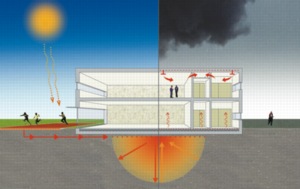Getting it right for low-carbon heating

Boosting the COP of heat pumps. A high-temperature heat source for heat pumps at Howe Dell primary school in Hertfordshire is achieved by gathering energy from beneath the Tarmac-surfaced playground and storing it in an ICAX ThermalBank under the school The surface temperature of Tarmac can often reach 15 K higher than the ambient air. The temperature of the ground below the insulated foundation of the school can be increased from its natural temperature of 10°C to over 25°C during the summer.
Making full use of low-carbon technologies for space heating necessitates a fresh view and a more holistic approach, says Ant Wilson of Faber Maunsell.In an increasingly energy-conscious world, there is more pressure and incentive to reduce carbon emissions from buildings. At the same time, it is a fact of life that we will always need heating. We will always need to introduce fresh air at temperatures that, in the UK at least, are generally lower than acceptable indoor temperatures. Also, we will always need hot water, and there are even times when we need to pre-heat the air that is used for cooling. Consequently, the only sensible way forward is to find better ways of heating buildings by making more use of low- or zero-carbon (LZC) technologies. This, in turn, presents a number of challenges and will often require a re-think of traditional methods. One thing that is certain, and based on traditional views, is that we need to improve the building envelope so that heating loads are greatly reduced. Better insulation reduces heat loss and increases the temperature of internal surfaces, so less space heating is required to compensate. We can also make more extensive use of demand-controlled ventilation so there is less fresh air to heat — and ensure that all heating is properly controlled. Taking these measures in the first instance greatly increases the opportunities for LZC heating technologies. A big challenge is getting the cost equation right with the allocation of space in plant rooms, for the relative sizing compared with gas, oil or electric. In addition, with solar and heat pump technologies, there is generally more heat available in the summer when we need it least. Surmounting these potential difficulties in the most effective fashion necessitates some kind of interseasonal storage to compensate. This could be in the form of massive, super-insulated storage tanks for hot water, or there may be more innovative methods available. For example, one project recently made use of the car park to store underground heat. Effectively, the black asphalt surface acts a huge heat absorber and heats the ground beneath, so that heat can then be recovered from a relatively shallow depth using a ground source heat pump. Most of the heat is stored during the summer, but such a surface will continue to top up heat reserves through most of the year. Similarly, solar-thermal arrays can be used to heat a ground source when there is surplus heat available, so this can be recovered in the winter. Both these methods will help to address the emerging concern that ground-source heat pumps are failing to deliver the coefficients of performance (COPs) expected of them. Raising ground temperature artificially, rather than relying on Mother Nature, will help ground source heat pumps to deliver COPs in excess of those that can be achieved with conventional heat sources. Another downside of ground-source heat pumps is the higher cost of installation compared with air-source heat pumps, so there is also a strong case for improving the COP of air-source heat pumps.

The abundance of solar energy that falls on the UK during the summer can be used to heat a ground source to provide energy for heat pumps in the winter.
One obvious approach is to use extract air from buildings, which can have a temperature of around 20ºC, to give the heat pump a boost. Even when heat is recovered from the air before it is exhausted (as it should be) it will still be significantly above ambient temperatures for much of the year. The same principle can be applied using the heat extracted from cooling a building, using this to drive the heat pump and generate hot water. Nor should we confine our ‘thinking outside the box’ to the heat source itself. We also have to be realistic about what we can expect from the relationship between the type of LZC and the temperature required. If we are looking for water at 80ºC, for example, we are going to be very disappointed if using heat pumps. However, if we use larger heat emitters we can heat effectively with lower water temperatures. Which, incidentally, we should also be thinking about with condensing boilers, as the lower return temperatures will provide more condensing. As mentioned earlier, control is also an important consideration, and we really need to stop heating for thermostats and start heating for people — because thermostats only measure air temperature, not comfort levels. Not only does control need to address comfort, it also needs to be more finely controlled in zones to ensure that the heating needs of each ‘micro-climate’ are addressed, rather than taking an average across the space. Given that ambient temperature will have some effect on internal surface temperatures, even with high insulation, set-points can also be made more adaptive to the season and external conditions. Ultimately each project will have its own quirks and its own opportunities. The fundamental issue is that we need to create the right building environment to enable us to make innovative use of LZC technologies.
Ant Wilson is with Faber Maunsell.
Related links:
Related articles:









